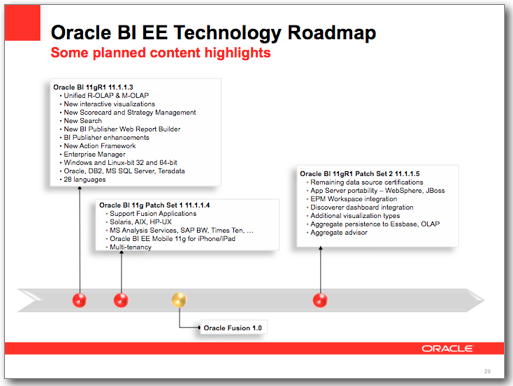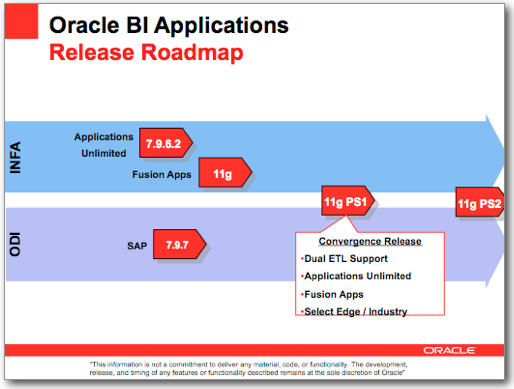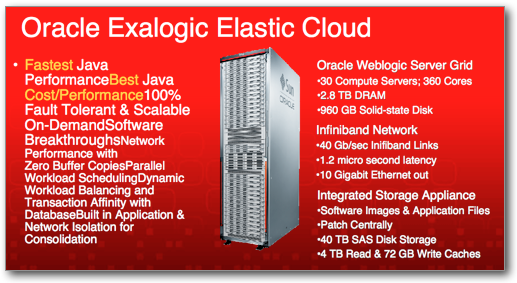Thoughts on BI at Oracle OpenWorld 2010
Well, I'm finally back from San Francisco and Oracle Open World, having spent two days at Oracle's HQ in Redwood Shores and then just over a week downtown in San Francisco at the Moscone Center. If you came to any of our presentations and are looking to download the slides, here they are:
- Oracle GoldenGate : What's All The Fuss About? Borkur Steingrimsson
- The Three R's of Data Warehouse Fault Tolerance Stewart Bryson
- Real-Time Data Warehousing with OBIEE and Oracle Database Stewart Bryson
- Exadata and OBIEE Retail Case Study Jon Mead
- OBIEE 11g Answers, Dashboards & More Mark Rittman
- OBIEE 11g Architecture Best Practices and New Features Mark Rittman
- OBIEE 11g Data Modeling Best Practices and New Features Mark Rittman
- Oracle Business Intelligence & Oracle Fusion Middleware 11g Venkat Janakiraman
- ETL Loads on Essbase & Planning with Oracle Data Integrator 11g Venkat Janakiraman
So how did the conference go? Well, the obvious main news from a BI perspective was the recent release of OBIEE 11g, with the 11.1.1.3 release becoming generally available late in August and most of the keynotes recapping on the main features. From speaking to delegates, most knew of the new features but only a few had managed to get it installed and have a good look, with very few getting beyond the new features in Answers and a quick play-around with Enterprise Manager. Over the week I did three sessions on my own around OBIEE (on the new visualizations, on systems management and architecture, and on RPD modeling), and two with Oracle's Phil Bates on enterprise features and on upgrading from 10g. The feedback on the various sessions was excellent, and I think the time we took over the summer to get "under the covers" of the new release has certainly been worthwhile.
The OBIEE roadmap and strategy sessions set out the objectives for the current, and next two "point" releases;

- OBIEE 11.1.1.3 - the release we have now, with new UI, action framework, scorecards, WebLogic integration, Enterprise Manager etc.
- OBIEE 11.1.1.4 - next patch set. Will support forthcoming Fusion Apps, also has better support for MS AS and SAP B/W, and new support for TimesTen. Platform support will extend to AIX, Solaris and HP-UX. Probably due late Q4 2010 or early Q1 2011. This is also the version that Oracle suggest you wait for, if using it with Oracle BI Apps 7.9.6.2
- OBIEE 11.1.3.5 - second patch set. Due Q3 2011? (my guess). J2EE server support will extend to WebSphere and JBoss. Aggregate persistence to Essbase and Oracle OLAP. Discoverer dashboard integration, and EPM Workspace integration. Aggregate advisor. Remaining 10g-era datasource certification.
There was also some talk of using TimesTen as an in-memory persistence layer for OBIEE, the idea being presumably that you could either load data into TimesTen and have it sit in memory, being analyzed by OBIEE like any other relational source; or perhaps, OBIEE might use TimesTen in the background automatically moving data into the database when pivot tables, for example, are required. I suspect it'll be more like the former as this'll be easier to engineer, but regardless of this I was surprised that TimesTen, rather than say an in-memory version of Essbase, is the focus of this initiative. My understanding of TimesTen is that it's more suited to data collection rather than data analysis and aggregation, but there may be some changes for the technology in the pipeline that make this viable. We'll have to wait and see.
Outside of BI, the main "software" news at Open World was the official launch of the Fusion Apps, with modules for HR, Financials, Supply Chain and so on likely to be available in the next few months. This then meant that more news became available on the first 11g release of the BI Apps, probably called 11.1.1.3 and due around December 2010.

This will support just the Fusion Apps as a data source, with later patch sets extending this support back to the "Applications Unlimited" (EBS, Peoplesoft, Siebel etc) data sources probably at least 12 months or so after the 11.1.1.3 BI Apps release. These patch sets will also aim to bring together the ODI and Informatica ETL, but details on this were sketchy so it may only apply to a subset of the data sources and mappings. Oracle also announced the BI Apps 7.9.6.2 release and said that, whilst it's supported with OBIEE 11.1.1.3, there are a number of known issues and it'll be properly certified with OBIEE release 11.1.1.4, with the advice being to hold on for 11.1.1.4 if possible.
The other major thing that struck me when seeing the Fusion Apps, and listening to the BI Apps and BI/EPM keynotes, was how much the Fusion BI Apps are integrated directly into the Fusion Apps (as opposed to running in their own standalone dashboards). The analytics within the Fusion BI Apps will come in two flavours;
- Oracle Transactional BI analytics, which will provide real-time reporting via ADF view objects on the Fusion Apps data, and
- traditional, Oracle BI Applications analytics, which will be against the Fusion BI Apps data warehouse.
Both of these will be integrated directly into the Fusion Apps user interface, with the OBIEE 11g Web Catalog being shown in folder form in the bottom left-hand corner of the UI, and reports, dashboards and visualizations being scattered all over the Fusion Apps user interface. As such, when Fusion comes along I'm not sure you'll be able to be an apps implementer without being a BI implementer, and vice versa - they'll be so intertwined that you'll not be able to do one without the other. Indeed, all Fusion Apps licenses will come with embedded OBIEE licenses, so we'll see Oracle's BI tool automatically included in all future Fusion Apps implementations. Something we'll need to think about at Rittman Mead going into the future.
The other big news from last week was around hardware, with a new version of the Exadata Database Machine being launched that had two nodes with eight cores rather than eight nodes with two cores each, on the basis that the reduction in inter-node RAC communication would be better for OLTP applications; and a new, Oracle Fusion Middleware appliance (see, I was right...) called Exalogic that came with 360 cores, shared disk for single-pass patching and tons of DRAM.

Exalogic is aimed at customers looking to consolidate lots of JEE applications on a WebLogic Server running on the box, on the basis that whilst database apps are I/O-bound, JEE apps are CPU-bound and this box certainly has lots of CPU. A lot of people asked me whether this would be useful for BI applications; in my view, it's pretty much 100% certain that Oracle will use technology like this to create a "BI Appliance" at some point, giving you "BI in a Box" with zero software configuration and lots of capacity. But realistically, no BI systems that I've come across are constrained at the mid-tier, it's always the database that's the issue, and I've seen OBIEE systems running with thousands of users just off of a couple of clustered commodity two-or-four core servers. So it certainly looks sexy, but I can't see many being bought just for BI applications.
Anyway, that's it for now. We're off to Manchester and London later this week to run two OBIEE 11g seminars, then I'm off to Copenhagen for a local user group Oracle Applications/BI day. Just enough time to unpack and then I'll be off again.